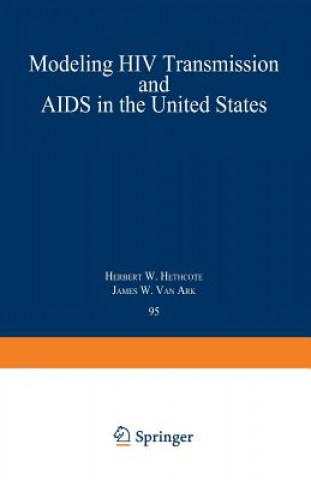
Doručení
Nákupní rádce





Nehodí se? Vůbec nevadí! U nás můžete do 30 dní vrátit
 Dárkový poukaz
V libovolné hodnotě
Dárkový poukaz
V libovolné hodnotě
S dárkovým poukazem nešlápnete vedle. Obdarovaný si za dárkový poukaz může vybrat cokoliv z naší nabídky.
Modeling HIV Transmission and AIDS in the United States
 Angličtina
Angličtina
 154 b
154 b
30 dní na vrácení zboží
Mohlo by vás také zajímat


This monograph describes the results of a project to use mathematical modeling and computer simulations to analyze HIV transmission dynamics and AIDS in various risk groups in the USA. Because there is more data available on homosexual men in San Francisco, this population is analyzed intensively. The risk groups considered in fifteen subregions of the USA are homosexual men, injecting drug users (IDUs), homosexual IDUs, heterosexual partners of IDUs and children of female heterosexual partners and IDUs. A goal is to understand the AIDS epidemic in the USA by using a modeling approach to analyzing the data. This monograph contains data, graphs and computer program listings. Although mathematical models are used, this book does not require a mathematical background so it is accessible to epidemiologists, modelers, mathematicians, and students who are interested in the epidemiology of AIDS or in how modeling can contribute to the understanding of the transmission. The disease that came to be called acquired immunodeficiency syndrome (AIDS) was first identified in the summer of 1981. By that time, nearly 100,000 persons in the United States may have been infected with human immunodeficiency virus (HIV). By the time the routes of transmission were clearly identified and HIV was established as the cause of AIDS in 1983, over 300,000 people may have been infected. That number has continued to increase, with approximately 1,000,000 Americans believed to be infected in 1991. The epidemic is of great public health concern because HlV is infectious, causes severe morbidity and death in most if not all of those infected, and often occurs in relatively young persons. In addition, the cost of medical care for a person with HIV disease is high, and the medical care needs of HIV-infected persons place a severe burden on the medical care systems in many areas. Understanding and controlling the HIV epidemic is a particularly difficult challenge. The long and variable period between HIV infection and clinical disease makes it difficult both to forecast the future magnitude of the epidemic, which is important for health care planning, and to estimate the number infected in the last several years, which is important for monitoring the current status of the epidemic.
Informace o knize
 Angličtina
Angličtina




 Jak nakupovat
Jak nakupovat































